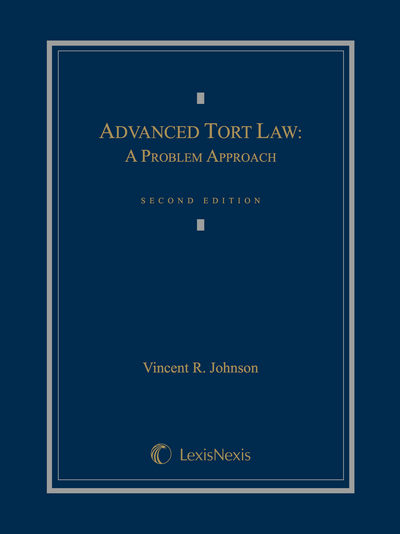This title has been replaced by a newer edition:
Advanced Tort Law: A Problem Approach, Third Edition
2020, 664 pp, casebound, ISBN 978-1-5310-1303-5
$204.00
Teacher's Manual available
Advanced Tort Law
A Problem Approach
Second Edition
2014
Tags: Torts
Teacher's Manual available
596 pp $186.00
ISBN 978-1-63044-783-0
eISBN 978-1-63044-785-4
This textbook is designed for use in upper-level law school courses. It reflects the belief that the most effective teaching materials for students beyond the first year of law school are centered on problems of the kind that lawyers face in practice. Other features of the book include:
- Clear Narrative Text. The chapters in Advanced Tort Law: A Problem Approach, Second Edition, focus on five intriguing subjects which normally receive little attention in basic torts courses: misrepresentation, defamation, invasion of privacy, tortious interference, and injurious falsehood. In each chapter, the law is laid out in a clear narrative format, which quotes liberally from pertinent court opinions, statutes, and other sources. Because upper-level law students are already well acquainted with the American litigation process, each topic focuses primarily on operative rules and policies, and their application to particular fact situations. The text minimizes the procedural complexities of cases that have already been decided.
- Fifty-Eight Discussion Problems. The main instructional feature of Advanced Tort Law: A Problem Approach, Second Edition, is the fifty-eight discussion problems. Roughly every eight to ten pages, there is a problem for students to prepare in advance of class. A good answer requires a confident grasp of the rules, concepts, and principles addressed in the text or in basic law school courses. The problems, which test whether students have learned the assigned material, are designed to form the basis for classroom discussions. If a class meets twice a week over the course of a typical law school semester, each reading assignment is likely to include about fifteen to twenty pages of reading material and two discussion problems. Other advanced torts books have few or no discussion problems, or contain discussion problems only in some chapters. Advanced Tort Law: A Problem Approach is the only textbook that uses discussion problems as the principal teaching device for every topic in the book.
- Preparation for Practicing Law in the 21st Century. Many of the problems in Advanced Tort Law: A Problem Approach are based on actual cases or stories in the news. With rare exceptions, the names have been changed. The facts in the problems often diverge from those which gave rise to the underlying disputes in order to raise questions important to the course. The discussion problems challenge students to explore how the law applies to the kinds of facts they will encounter in twenty-first century law practice. There is an abundance of citations to cases decided since 2000. The hypothetical scenarios are designed to help users of the book develop the problem-solving skills that effective lawyers need today.
- Cutting-Edge Legal Issues in the Digital Age. Although the torts discussed in this book are ancient in origin, they are often on the front lines of litigation in the Digital Age. There are abundant references to issues raised by recent communications technology developments, including blogging, texting, and social networking. The book addresses numerous practical questions that Americans confront in contemporary life, such as the liability issues that arise from anonymous postings on the Internet or from corporate press releases designed to mislead investors.
This book also is available in a three-hole punched, alternative loose-leaf version printed on 8.5 x 11 inch paper with wider margins and with the same pagination as the hardbound book.
The eBook version of this title features a link to Lexis Advance for further legal research options.



